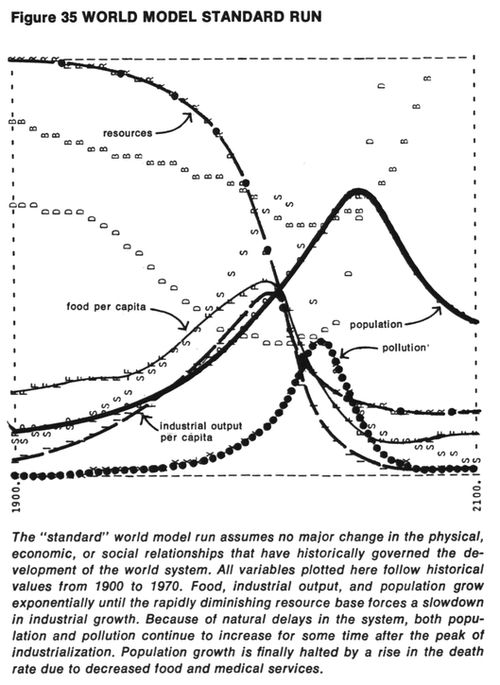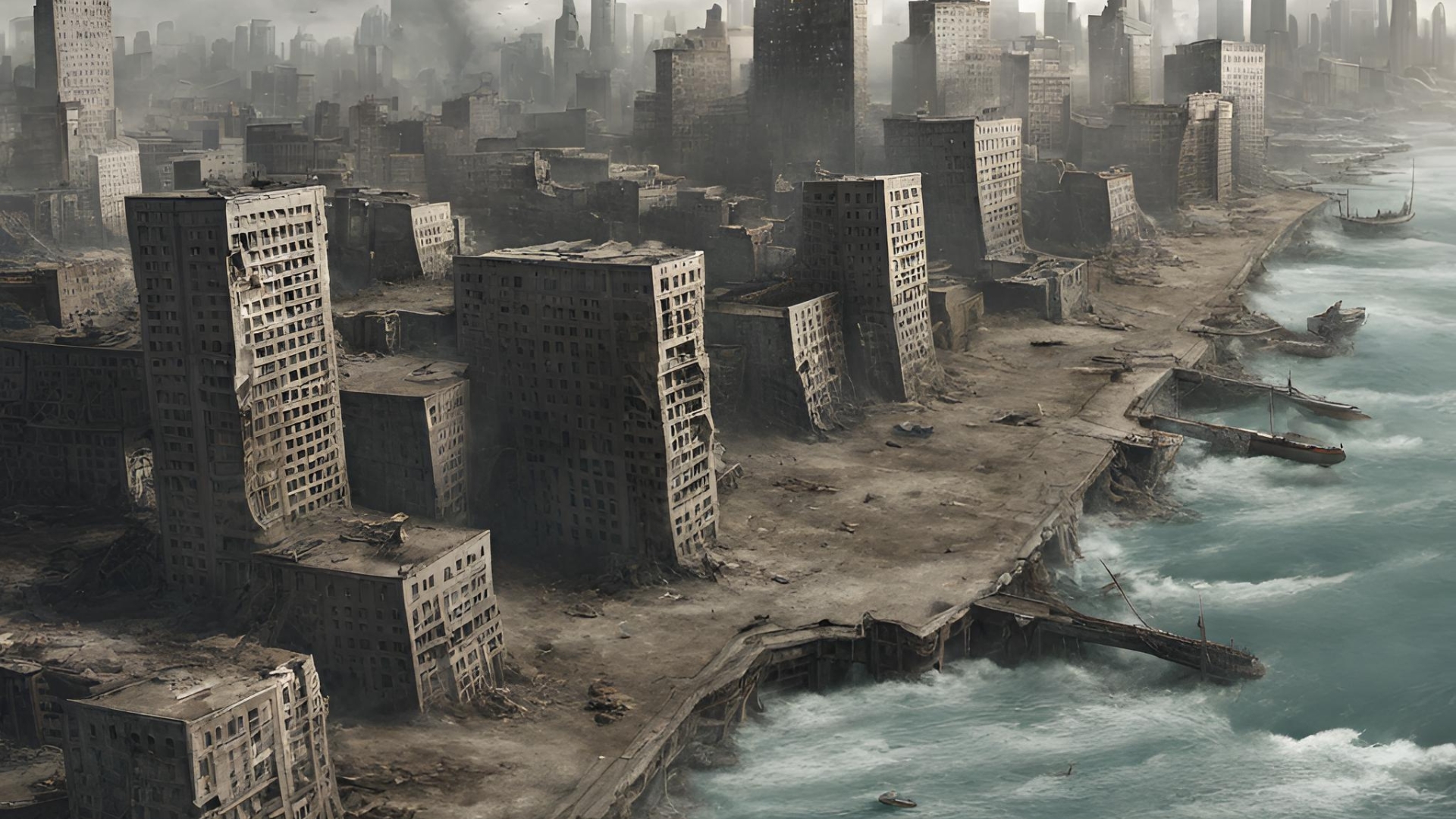Are we nearing global collapse?
Written by Olivia Nater | Published: February 5, 2024
A 1970s publication caused a big stir when it showed that continuing on business-as-usual population and consumption growth trajectories would likely lead to societal collapse within a century. Were the scientists behind it right?
A major scientific warning
If you’re a Population Connection supporter, you’re most likely familiar with The Limits to Growth (LtG), a seminal scientific report published in 1972 by think-tank The Club of Rome. Using computer models developed at the Massachusetts Institute of Technology (MIT), the authors demonstrated the danger of ignoring the finiteness of our planet. They warned,
“If the present growth trends in world population, industrialization, pollution, food production, and resource depletion continue unchanged, the limits to growth on this planet will be reached sometime within the next one hundred years. The most probable result will be a rather sudden and uncontrollable decline in both population and industrial capacity.”

In the LtG researchers’ “standard” model, which reflects business-as-usual, population, food production, and industrial output (a measure of economic growth) increase exponentially until rapidly diminishing natural resources cause an economic slowdown beginning around 1970. Population and pollution continue to increase for some time after peak industrialization, but decreased food and medical services cause death rates to rise from around 2020 onward, leading to a rapid fall in population beginning around 2030.
According to the LtG standard model, we are now roughly at the beginning of the end. The authors pointed out that given the many uncertainties in their model, it is not possible to accurately predict the date that things start going badly wrong, but that it is highly likely that growth will stop well before the year 2100. Is societal collapse this decade really that likely, and if so, can we still avert it? Let’s take a look at what experts think nowadays.
[As an aside, “collapse” does not necessarily mean human extinction. In his 2005 book, Collapse: How Societies Choose to Fail or Succeed, acclaimed scientist and author Jared Diamond defined it as “a drastic decrease in human population size and/or political/economic/social complexity, over a considerable area, for an extended time.”]
Accuracy of The Limits to Growth models
An independent 2014 analysis of the Limits to Growth models concluded that we had thus far been following the “standard,” business-as-usual scenario very closely, with world population and the global economy continuing to grow at roughly the same rates as in the decades before 1970.
The LtG researchers also ran several more optimistic models — some featured in their 1972 book, and some in later publications. A more recent, independent 2020 analysis of the accuracy of the LtG models found that the two scenarios that represented the closest fit to historical data were one in which natural resources are twice as abundant as in the standard model, and one that assumes rapid technological innovation.
The LtG authors included the doubled resources scenario in case their estimate of the global stock of resources was wrong. The scenario assumes technological discoveries and advances would double the amount of resources that can be extracted and used. In this scenario, collapse occurs, but is caused by pollution (interpreted in the 2020 analysis as including greenhouse gases leading to climate change), rather than resource depletion.
The technological innovation scenario, which also represented a close fit in the 2020 analysis, does avert collapse, but still leads to declines in human welfare because the cost of technology solutions becomes so high that not enough resources are left for food production and health and education services. The author also warned that even if extreme technofixes might prevent collapse, they probably won’t yield the kind of world most people desire:
“Why would we use our innovative powers to invent robot pollinators to replace the bees, if we also have the choice to invent agricultural practices that do not have the side effect of insecticide? Why use drones to plant new trees, when we could also restructure our economy so that existing forests are not cut and burned down?”
In her analysis, she also found that the most optimistic LtG scenario depicting a path to sustainability and stabilization of human welfare at a high level this century was the one that aligned the least closely with empirical data. She concluded that “humanity is on a path to having limits to growth imposed on itself rather than consciously choosing its own.”
In their 1972 book, the LtG authors made it clear that allowing infinite growth to continue would certainly result in a dire outcome. They noted,
“…if we want a stable system, it is not desirable to let even one of the two critical positive feedback loops [population and economic growth] generate uncontrolled growth. Stabilizing population alone is not sufficient to prevent overshoot and collapse; a similar run with constant capital and rising population shows that stabilizing capital alone is also not sufficient.”
Perversely, mainstream economists and governments generally act in opposition to this advice, striving for both continuous economic and population growth.
Is our environment at a breaking point?
Looking at the state of our environment, it’s not hard to imagine that collapse isn’t far off. Despite claims that growth can be decoupled from environmental damage through technological innovation, all our major environmental issues, from biodiversity loss to resource depletion to climate change, are still getting worse instead of better.
Recent scientific reports have warned that humanity has already breached the majority of critical planetary boundaries. In addition, climate data show we may exceed 1.5°C of global warming above pre-industrial levels within the next few years. Nations agreed to limit warming to 1.5°C under the 2015 Paris Agreement because scientists believe that exceeding this threshold could trigger irreversible, catastrophic consequences, such as the melting of the Greenland and Antarctic ice sheets, leading to major sea level rise.
 We are increasingly seeing the disastrous impacts of the climate crisis unfolding around the world, from devastating floods in Pakistan, to famine-exacerbating drought in Ethiopia, to record-breaking wildfires in Canada.
We are increasingly seeing the disastrous impacts of the climate crisis unfolding around the world, from devastating floods in Pakistan, to famine-exacerbating drought in Ethiopia, to record-breaking wildfires in Canada.
While most of the attention is on climate change, all environmental issues have the potential to become disastrous. A 2020 study published in Nature Scientific Reports, for example, argued that we are on course for collapse driven by deforestation. Forests play a vital role in carbon storage, oxygen production, soil and biodiversity conservation, and water cycle regulation — countless lives and livelihoods depend on healthy forests. According to the study’s models, maintaining current rates of population growth and deforestation would mean we have a less than 10 percent chance of avoiding “an irreversible collapse of our civilization” within just a few decades.
Make or break factors
Of course, a deteriorating environment doesn’t necessarily have to lead to collapse. A paper published last year looked at which factors determined whether past societies survived environmental shocks. Looking at examples of historical societies, the authors concluded that whether a society collapses is not just a function of the type and severity of the stressors but also depends on existing cultural, political, and economic structures. In times of crisis these structures can either help build resilience and facilitate positive adaptation, or undermine collective action and lead to unrest, violence, and societal collapse.
In other words, stable societies with high cohesion and cooperation can potentially withstand even dramatic shocks, whereas it doesn’t take much to cause chaos in vulnerable societies. Needless to say, the fact that global inequality and political polarization are on the rise does not bode so well for the resilience of modern societies.
In his book Collapse, Jared Diamond identified two crucial choices that determined whether past societies failed or survived; long-term thinking and reconsidering core values.
Decisionmakers and industry leaders usually pursue what benefits them in the short term, even if it’s bad for society in the long-term. A current example is governments and fossil fuel companies choosing to expand fossil fuel production even though they know this will worsen the climate crisis. This type of short-termism is not compatible with a sustainable future.
Regarding core values, modern capitalist societies have been conditioned to value material wealth above other things, but caring for each other and nature needs to become the new priority if we are to prevent overshoot-driven collapse.
Many people are well aware of the need for systemic change, long-term thinking, and valuing people and the environment over profit, and it is encouraging to see growing movements at the community level. Whether these movements can grow strong enough to pull humanity back from the cliff edge remains to be seen. But what’s clear is that we’re rapidly running out of time to prevent things from getting very bad.
Do you believe we’re headed for collapse, or do you think such predictions are too pessimistic? I would love to hear your thoughts — send them to me using the form below!

